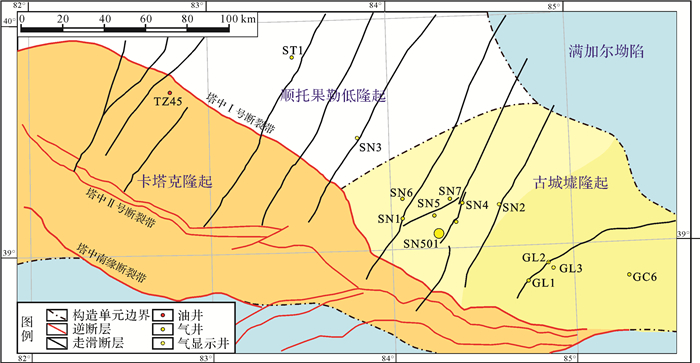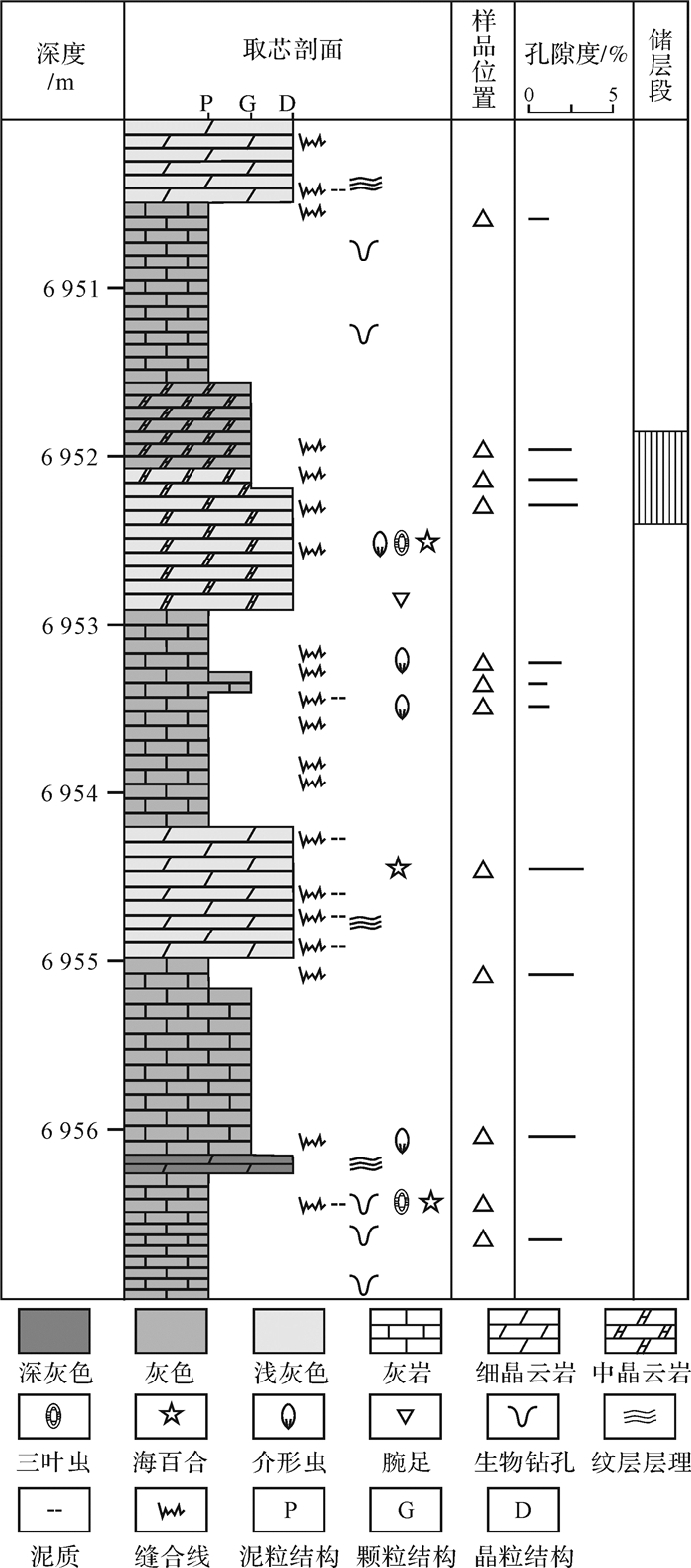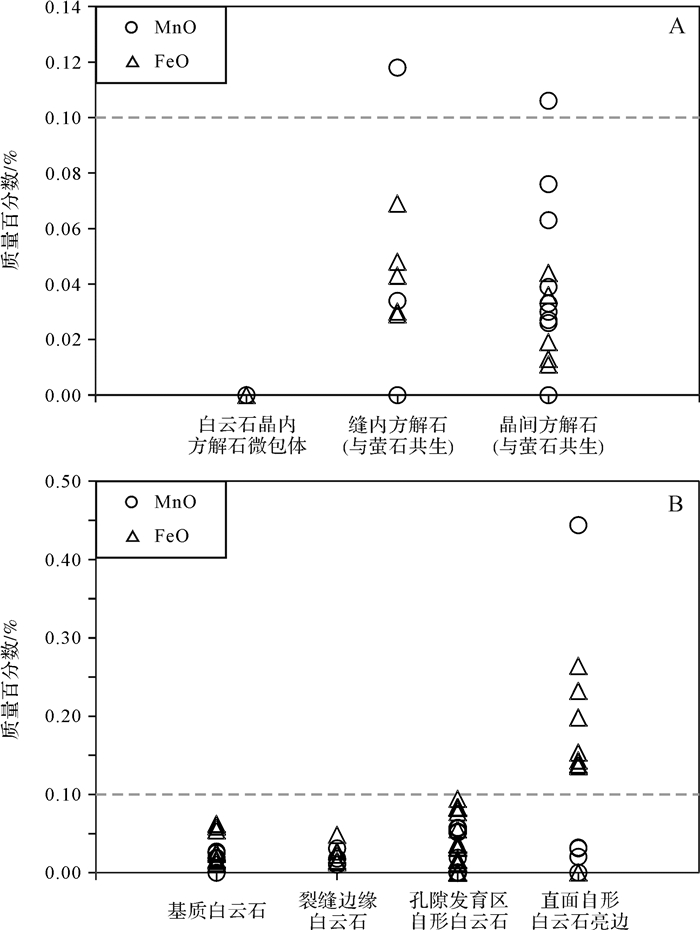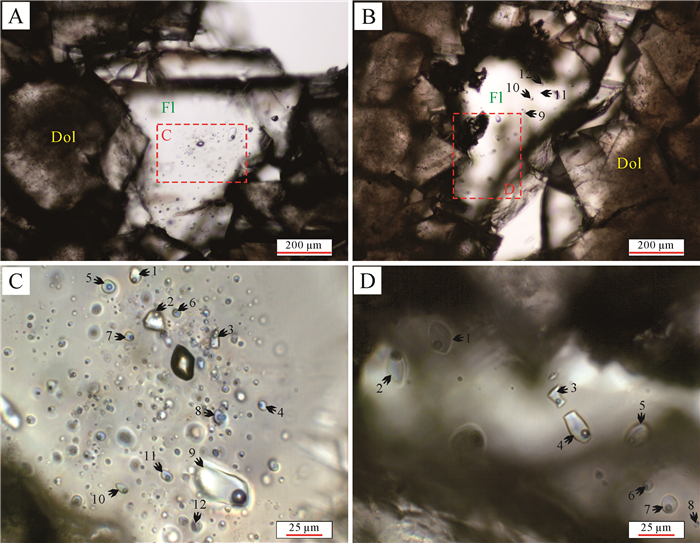扩展功能
文章信息
- 尤东华, 韩俊, 胡文瑄, 陈强路, 曹自成, 席斌斌, 鲁子野
- YOU DongHua, HAN Jun, HU WenXuan, CHEN QiangLu, CAO ZiCheng, XI BinBin, LU ZiYe
- 塔里木盆地顺南501井鹰山组白云岩储层特征与成因
- Characteristics and Genesis of Dolomite Reservoirs in the Yingshan Formation of Well SN501 in the Tarim Basin
- 沉积学报, 2018, 36(6): 1206-1217
- ACTA SEDIMENTOLOGICA SINCA, 2018, 36(6): 1206-1217
- 10.14027/j.issn.1000-0550.2018.092
-
文章历史
- 收稿日期:2017-10-18
- 收修改稿日期: 2017-12-28
2. 中国石化石油勘探开发研究院无锡石油地质研究所, 江苏无锡 214126;
3. 中国石化西北油田分公司勘探开发研究院, 乌鲁木齐 830011;
4. 中国地质大学(武汉)能源学院, 武汉 430074
2. Wuxi Research Institute of Petroleum Geology, SINOPEC, Wuxi, Jiangsu 214126, China;
3. Northwest Oilfield branch of Exploration and Development Research Institute, SINOPEC, Urumqi 830011, China;
4. Department of Petroleum Geology, Faculty of Earth Resources, China University of Geosciences, Wuhan 430074, China
诸多学者针对塔里木盆地白云岩开展了白云岩成因与白云石化模式[1-4]、白云岩储层成因[5-7]研究,其中与热液成因[8-9]以及热液蚀变相关的白云岩[10]与白云岩储层[6, 11-13]是研究重点之一,以鞍状白云石、石英等热液矿物组合作为重要鉴别标志,并提供了相关的岩石学、地球化学证据。热液成因萤石作为深部热液流体活动的标志之一,已有的文献报道主要集中于奥陶系灰岩地层,如塔中45井、西克尔露头剖面[14-18]。塔里木盆地奥陶系白云岩中热液萤石及相关白云岩储层的研究鲜有报道。
近几年,在塔里木盆地塔中Ⅰ号断裂带以北的顺南地区取得重大天然气勘探突破[19-20]。天然气主要集中在鹰山组下段白云岩储层(顺南5井区、顺南6井、顺南7井)、鹰山组上段热液蚀变型裂缝—孔洞型/孔隙型硅化岩储层(如顺南4井、顺南401井)、一间房组裂缝—孔隙型灰岩储层(顺南1井、顺南7井)。其中,鹰山组下段白云岩储层的特征以及成因一直以来困扰着研究人员。在钻井、录井、测井过程均存在显著的储层响应特征,如泥浆的漏失、气测异常、天然气产出,但取芯资料基本未见优质储层。目前,仅在顺南501井取芯段岩石样品的显微薄片中见到少量裂缝与孔隙。因此,对鹰山组下段白云岩储层的成因与发育机制存在多种猜测,主要包括有利岩相与埋藏白云石化作用的控储机制[21-23]、构造—热液成因机制[13, 24-25]、受(高频)层序界面控制的岩溶储层机制[26-28]。对白云岩储层特征与成因认识的不确定性制约了该地区在鹰山组下段以及蓬莱坝组的进一步勘探部署。受钻孔岩芯资料的制约,本文以顺南501井为例,通过岩石学特征、储集空间表征与地球化学分析探讨储层成因,为该地区白云岩储层成因机制的建立提供参考。
1 区域地质概况塔里木盆地顺南地区位于古城墟低隆起西侧,南以塔中Ⅰ号断裂带为界,与卡塔克隆起相邻,北接满加尔坳陷,西为顺托果勒低隆起(图 1)。区内油气勘探的主要目的层位于中下奥陶统碳酸盐岩地层。中奥陶统碳酸盐岩顶面总体表现为东南高、西北低[20]。

|
| 图 1 顺南501井区域位置图 Figure 1 SN501 well location in Tarim Basin |
寒武纪至早中奥陶世在弱伸展的构造背景下,塔里木盆地表现为“东西分异、东盆西台”的沉积格局[29-30]。在台地相区沉积了巨厚的碳酸盐岩地层。顺南地区位于台地边缘相以西的碳酸盐岩台地相区。寒武系地层以白云岩和蒸发岩为主要岩性。中下奥陶统地层自下而上依次为蓬莱坝组(以白云岩为主要特征)、鹰山组(下段以灰岩夹白云岩为主,上段以灰岩为主)、一间房组(藻灰岩、藻粘结灰岩为主)。
中奥陶世末受加里东中期Ⅰ幕构造运动的影响,沉积盆地从“东西分异”向“南北分带”转化[29-31]。塔中Ⅰ号断裂带形成,且卡塔克隆起区一间房组与鹰山组遭受剥蚀。晚奥陶世早期受全球海平面上升的影响,沿塔中Ⅰ号断裂带形成良里塔格组礁滩相台地边缘建造,而塔中Ⅰ号断裂带以北地区以深水斜坡(恰尔巴克组)—盆地相沉积为特征[32-33]。晚奥陶世晚期受塔里木南缘板块碰撞的影响,盆地内快速堆积了巨厚的碎屑岩沉积,卡塔克隆起区为桑塔木组,而塔中Ⅰ号断裂带以北为却尔却克组。由于北西向塔中Ⅰ号断裂带逆冲断层在走向上断层位移量的不一致,导致了断裂带之间北东向被动调节断层的产生,宏观上表现为塔中Ⅰ号断裂带的分段性[34-35]。奥陶纪末受东南阿尔金洋盆构造域聚敛作用的影响,古城墟隆起开始发育,中上奥陶统却尔却克组遭受一定程度的剥蚀。志留纪,古城墟隆起区进一步抬升。塔中Ⅰ号断裂带以北地区志留系碎屑岩沉积主要受古地貌的控制,自西北向东南超覆尖灭[20]。加里东晚期至海西早期,构造运动使得塔中Ⅰ号断裂带调节断层继承性活动形成北东向走滑断层,并扩展至塔中Ⅰ号断裂带以北广大地区。该走滑断层切割志留系地层且形成一系列相关标志[36-37],如花状构造、拉分地堑、马尾状断裂组合、雁列断层系统、海豚效应与丝带效应等。晚泥盆至石炭纪地层以超覆沉积为主,北东向走滑断层无继承性活动。早二叠世在拉张背景下,岩浆活动主要集中在塔里木盆地中西部。顺南地区二维与三维地震剖面上未见同期的岩浆侵入与喷发活动。
平面上,自北西向南东展布了数排北北东或北东东走向的走滑断裂带(图 1),主要活动期为加里东中期与海西早期。加里东中期(中奥陶世末),走滑断裂表现为压扭性质;海西早期(中泥盆世末),在加里东中期压扭性走滑断裂的基础上继承性发育了张扭性走滑断裂[36-38]。由于走滑断层桥的流体泵吸机制[39],张扭走滑断裂的拉分段通常有利于热液流体活动,并改造围岩形成热液改造型碳酸盐岩储层[40-42],如顺南4井、顺南401井。顺南501井临近顺南5井北东东向断裂(井距约9 km),靠近顺南4井北东向断裂带(井距约18 km),具备裂缝发育与热液活动的地质条件(图 1)。该区走滑断裂几何学、运动学的研究[38]与顺南4井成岩序列分析、流体包裹体的约束,结合埋藏史—热史的研究[42],均表明热液流体活动最可能的时间为中泥盆世末。
顺南地区进入鹰山组下段地层的钻井共六口,分别为顺南5井、顺南501井、顺南5-1井、顺南5-2井、顺南6井、顺南7井。钻井揭示鹰山组下段岩性以灰岩为主,夹薄层白云岩。鹰山组储层测井解释以三类裂缝性储层为主,少量二类储层。
2 样品采集与分析方法对顺南501井取芯段在详细观察描述的基础上采集样品共12件(图 2)。每件样品制作了0.03 mm厚的铸体薄片与0.05 mm厚的铸体光薄片,使用Leica DM4500P偏光显微镜进行显微岩石学观察。对其中11件2.5 cm直径柱塞样进行了氦气法孔隙度测定。

|
| 图 2 顺南501井鹰山组下段取芯段沉积—储层综合柱状图 Figure 2 Core column with sedimentary and reservoir characteristics of the lower Yingshan Formation in Well SN501 |
在显微岩石学分析基础上,通过Leica体视显微镜对孔隙发育的铸体薄片进行宏观图像采集,然后通过“孔隙及裂隙图像识别与分析系统”软件[43]对孔隙的长度、宽度、面积百分比等孔隙参数进行统计。使用GE Phoenix Nanotom m对2.5 cm直径柱塞样进行计算机断层扫描分析,扫描电压110 kV,扫描电流110 μA,扫描精度12.67 μm,扫描时间120 min。在偏光显微观察基础上,使用JEOL JXA-8230型电子探针进行背散射电子成像与元素Fe、Mn含量分析,加速电压15 keV,电流强度20 nA,电子束斑直径2~5 μm。Fe的分析精度为160×10-6 mg/g(相当于FeO检测限的质量分数约为0.02%),Mn的分析精度为142×10-6 mg/g(相当于MnO检测限的质量分数约为0.018%)。每个点的分析数据需要依据检测限评估分析结果的可靠性。以上分析工作均在中国石化石油勘探开发研究院无锡石油地质研究所油气成藏重点实验室完成。
流体包裹体显微测温工作在里贾纳大学地质流体与沉积地球化学实验室进行。流体包裹体显微测温在Linkam THMGS600冷热台上完成。冷热台通过已知成分的合成流体包裹体进行了校准。均一温度测定的加热与循环间隔为1 ℃,冰点温度的加热与循环间隔为0.1 ℃,即流体包裹体均一温度测量精度为±1 ℃,而冰点温度测量精度为±0.1 ℃。
3 储层发育特征 3.1 岩石学特征顺南501井鹰山组取芯段总体表现为厚层灰岩夹薄层白云岩的岩性组合特点(图 2)。灰岩呈灰色,以泥粒结构为主,局部为亮晶颗粒结构,发育生物钻孔、缝合线、泥质条带,生物碎屑以介形虫、三叶虫、海百合为主。缝合线附近发育少量200 μm左右的直面自形白云石。薄层白云岩可细分为具残余结构中晶白云岩、细晶白云岩,无残余结构中晶白云岩。具残余结构白云岩呈灰色—浅灰色,白云石粒径约200 μm,局部未被白云石交代的区域具有原始灰岩的亮晶颗粒结构特征。细晶白云岩具有深灰色、浅灰色两种类型,白云石粒径为20~50 μm,均无残余结构并发育纹层构造,含泥质与少量海百合碎屑,普遍发育缝合线,白云石晶间见少量方解石。无残余结构中晶白云岩呈浅灰色,直面自形—半自形白云石粒径约200 μm,生物碎屑主要有三叶虫、海百合、介形虫、腕足,发育缝合线。
3.2 储集空间与储集性能中晶白云岩中发育少量储集空间。铸体薄片分析表明主要有两种类型:一、微裂缝以及扩溶缝(图 3A),二、白云石晶间孔与晶间溶孔(图 3B)。

|
| 图 3 顺南501井鹰山组白云岩储集空间特征 A.微裂缝与扩溶缝(红色虚线,局部位置见图 4A),铸体薄片,6 952.06 m;B.白云石晶间孔、晶间溶孔(局部位置见图 4A),与A为同一铸体薄片;C.裂缝内萤石与方解石共生,背散射照片,黑色为储集空间,6 952.18 m;D.与C为同一个裂缝,基质白云石具有较多方解石微包裹体,裂缝边缘局部白云石晶内含有萤石(绿色箭头),背散射照片,黑色为储集空间,6 952.18 m;E.白云石晶间萤石(绿色箭头、白色)与方解石(蓝色箭头、浅灰色)共生,背散射照片,黑色为白云石晶间孔隙,6 952.18 m;F.晶间孔发育区白云石含少量方解石微包体,局部白云石晶内(黄色箭头)包含萤石晶体,黑色为白云石晶间孔隙,6 952.18 m。Dol.白云石;Cal.方解石;Fl.萤石 Figure 3 Characteristics of dolomite reservoir space in the Yingshan Formation of Well SN501 A. micro-fractures and expansion fractures (red dashed line, local position shown in the figure 4A), casting thin section, 6 952.06 m; B. Intercrystalline pores and intercrystalline solution pores (local position shown in the figure 4A), the same casting thin section with A; C. Fluorite and calcite coexisted in the fractures, backscattered image, the color of black is reservoir space, 6 952.18 m; D. The same fracture with C, the matrix dolomite with a large amount of micro calcite inclusion, the dolomites at the edge of fracture contain fluorite (green arrow), backscattered image, the color of black is reservoir space, 6 952.18 m; E. Fluorites (green arrow) and calcites (blue arrow) coexisted in intercrystalline pores among dolomites, backscattered image, the color of black is reservoir space, 6 952.18 m; F. Dolomites in the area of intercrystalline pores with rare calcite micro inclusions, dolomite in local position (yellow arrow) contains fluorite, the color of black is reservoir space, 6 952.18 m. Dol. dolomite, Cal. calcite, Fl. fluorite |

|
| 图 4 基于铸体薄片的孔隙与裂缝关系 A.铸体薄片下储集空间的宏观特征,右侧区域未盖片并使用茜素红染色,粉红色为方解石矿物,Fl为萤石(绿色箭头);B.铸体薄片中可分辨的微裂缝、扩溶缝(红色虚线);C.基于铸体薄片宏观照片使用图像分析软件提取的裂缝与孔隙分布特征 Figure 4 Relationship between pores and fractures based on image analysis of casting thin section A. macroscopic characteristic of the reservoir space under the casting thin section, the uncover area on the right was stained by Alizarin red, the color of pink is calcite minerals, Fl is fluorite (green arrow); B. micro-fractures and expansion fractures, which can be identified in casting thin section (red dashed line); C. fractures and pores distribution characteristics extracted by image analysis software based on macroscopic photograph of casting thin section |
微裂缝通常延伸较短,具有一定的定向性,沿微裂缝可见一定程度的扩溶。裂缝边缘常见“干净透明”的白云石(方解石微包体不发育),明显区别于基质部分的“较脏”白云石(方解石微包体较多)。裂缝、扩溶缝内局部充填共生的方解石与萤石,少量萤石位于裂缝边缘的白云石晶内(图 3C,D)。
白云石晶间孔、晶间溶孔呈不均匀分布,局部呈片状发育。该区域白云石较原始基质白云石更“亮”或“雾心亮边”的环带结构更明显。白云石晶间除残留孔隙外,还分布共生方解石、萤石,少量萤石位于白云石晶内(图 3E,F)。该取芯段2.5 cm直径柱塞样孔隙度为1.09%~3.27%,平均值为2.21%(N=11);其中,在铸体薄片中可观察到储集空间的柱塞样孔隙度为2.5%~2.93%,平均为2.78%(N=3)。
3.3 主要成岩作用及次序鹰山组经历的主要成岩作用有准同生期白云石化作用、生物钻孔及相关白云石化作用、强烈的压实压溶作用、埋藏白云石化作用、构造—热液作用。
发育纹层构造的细晶白云岩可能受沉积作用的控制。白云石晶体小且自形程度好,推测此类白云石最早形成于准同生期,且受控于层控白云石化流体的作用,埋藏期进一步发生了重结晶作用。泥粒灰岩局部发育斑点状生物钻孔,且其主要由白云石构成。沉积期至浅埋藏早期生物钻孔有利于微生物活动,并在微生物介导作用下形成生物钻孔相关的白云石。埋藏成因白云石主要有四种表现形式:粒间白云石胶结物、粒内交代成因白云石、灰泥基质交代成因白云石、与缝合线相关的白云石。白云石呈直面自形,数百微米大小,分散状分布。粒间白云石胶结物可能形成于成岩早期,随埋深增加温度增高粒间孔隙水逐渐克服了白云石结晶的动力学障碍,在粒间孔隙形成自形—半自形白云石胶结物。粒内交代成因白云石的形成可能受局部渗透性控制,白云石的形成局限于颗粒内部。与粒间白云石胶结物相比,其形成可能稍晚(晚于粒间方解石胶结物的形成),但均属于成岩早期。灰泥基质中呈分散漂浮状的直面自形白云石亦形成于成岩早期,代表灰泥基质具有孔隙水及良好的渗透性。与缝合线相关的白云石可能是以上三种类型白云石的集中表现形式,压实压溶作用使得分散的白云石沿缝合线集中分布。
鹰山组下段取芯揭示压实压溶作用非常强烈,缝合线分布广泛。灰岩、细晶白云岩、中晶白云岩中缝合线普遍存在。灰岩中可见缝合线之间的颗粒强烈变形,而缝合线附近的颗粒亦发生了明显变形。从大量的薄片分析看,局部中晶白云岩的形成可能与强烈压溶作用相关。直面自形、数百微米大小的白云石在压实压溶作用下逐步向缝合线附近堆积,强烈的压实压溶逐步导致方解石大量溶解与白云石的进一步富集,表现为缝合线在中晶—粗晶白云岩中的高密度分布。
从储集空间的岩石学特征分析看,白云岩形成之后还存在一期热液作用。岩石学特征为萤石与方解石共生,充填于裂缝与孔隙之中(图 3),局部萤石沉淀于白云石晶内(图 3F)。前人在塔里木盆地已开展过以萤石为代表的热液流体与储集空间形成的关系研究,主要集中于塔中45井与西克尔剖面[15-18]。在塔中北坡顺南地区首次发现萤石,且其分布于白云岩储层中。由于F-离子在海水或正常海相碳酸盐岩中含量极低,萤石的出现可能代表了热液流体的加入。
由此可见,主要的成岩作用次序为准同生期白云石化作用(直面自形细晶白云石,20 μm左右)→生物钻孔及相关白云石化作用→埋藏白云石化作用(粒间与粒内白云石、与缝合线相关白云石、分散分布的自形白云石,数百微米大小)→构造热液作用(萤石与方解石的沉淀)。
4 储层成因探讨白云岩储层成因同白云石成因一样具有多解性。已有诸多学者基于地质、地球化学分析提供了多种成因模式,如白云石化过程通过等摩尔置换产生孔隙[44]、构造—热液控制下形成的热液白云岩储层[45]、与蒸发岩溶解作用相关的白云岩储层[46]、与热硫酸盐还原作用相关的白云岩储层[47-50]等。本文从孔隙与裂缝的关系、储层成因的地球化学响应二个方面对顺南501井鹰山组白云岩储层的成因进行讨论。
4.1 孔隙与裂缝的关系基于铸体薄片宏观图像分析与岩石CT扫描,从二维空间与三维空间两个方面探讨孔隙与裂缝的关系。
(1) 二维空间
铸体薄片中孔隙与裂缝的宏观岩石学特征是探讨储层成因的基础。从铸体薄片的宏观特征看,微裂缝、扩溶缝具有一定程度的定向性与延伸性(图 4、图 3A),而白云石晶间孔、晶间溶孔局部呈片状发育(图 4、图 3B)。孔隙发育区与微裂缝产状具有一定关系,微裂缝、扩溶缝是孔隙发育区之间的“桥梁”。微裂缝与扩溶缝附近是白云石晶间孔、晶间溶孔发育的主要区域(图 3A、图 4)。铸体薄片孔隙图像(图 4C)定量分析表明,大部分孔隙长度为50~100 μm、宽度 < 50 μm、长宽比为1~3(N=737),具裂缝型孔隙特征。铸体薄片面孔率仅为0.85%,孔隙分布的局限性可能表明孔隙发育与裂缝具有相关性。
(2) 三维空间
计算机断层扫描成像为三维空间孔隙与裂缝关系可视化提供了条件。在CT扫描重建的三维数据体中选择两条微裂缝(F1、F2)作为参照,提取能识别的裂缝与孔隙(扫描分辨率为12.67 μm)构建三维透视图。由于胶结物充填程度差异,微裂缝F1、F2呈不完全连续的面,其他为分散的孔隙空间(图 5)。旋转三维透视图从不同角度观察分散的孔隙与微裂缝F1、F2的空间关系,在微裂缝附近孔隙明显较为发育(图 5)。

|
| 图 5 微裂缝与孔隙空间的三维透视图(F1、F2代表相对连续的微裂缝空间) Figure 5 Three-dimensional perspective of micro-fractures and pores space (F1, F2 represent relatively continuous micro-fracture space) |
基于储集空间的分析可知,微裂缝、扩溶缝与白云石晶间孔、晶间溶孔是主要的储集空间。关于其成因的地球化学分析主要针对孔隙与裂缝附近不同产状方解石、白云石的Fe、Mn含量对比,以及萤石中流体包裹体的分析。
(1) 方解石与白云石的Fe、Mn含量
由于碳酸盐岩成岩过程是Fe、Mn不断获取的过程[51-53],因此碳酸盐矿物的Fe、Mn含量是判断其经受成岩蚀变程度、成岩序次的重要依据。此外,热液流体对碳酸盐岩的改造过程会导致碳酸盐矿物Fe、Mn含量的增加[54-55]。
以基质白云石(图 3D)晶内的方解石微包体代表原始海相碳酸盐矿物的Fe、Mn特征,以裂缝以及白云石晶间与萤石共生的方解石代表与储集空间形成相关的流体Fe、Mn特征。以具有方解石微包体的基质白云石代表成岩早期白云石化流体的Fe、Mn特征,以充填萤石与方解石的裂缝边缘的白云石、孔隙发育区的自形白云石(含少量方解石微包裹体或纯白云石、图 3E)、包含萤石的白云石亮边(图 3F)代表其受后期流体改造或影响的特征。
从电子探针的Fe、Mn元素分析结果看(图 6A),与萤石共生的方解石较基质白云石晶内方解石具有更高的Fe、Mn含量。白云石Fe、Mn含量总体一致(图 6B),其与萤石共生的方解石具有相似的Fe、Mn含量特征(FeO、MnO的质量百分数大部分均低于0.10%,MnO质量百分数0.10%相当于Mn2+含量约775 mg/g、FeO质量百分数0.10%相当于Fe2+含量约780 mg/g),表明基质白云石、受后期流体影响的白云石、与萤石共生的方解石均为埋藏条件下的产物。由于矿物沉淀的环境条件差异不大且均为相对缓慢的过程,埋藏条件下Fe2+、Mn2+进入碳酸盐矿物晶格的量差异性较小。局部的差异性可能是由于流体中Fe、Mn含量差异,以及不同条件下Fe、Mn在碳酸盐矿物中的分配系数差异造成。包含萤石的白云石亮边具有最高的Fe含量(FeO百分含量大部分高于0.10%),代表该白云石受到强烈的后期流体改造(白云石发生了晶内溶蚀与萤石沉淀)。

|
| 图 6 方解石(A)与白云石(B)的FeO、MnO含量对比 Figure 6 Comparison of FeO and MnO contents in calcite(A) and dolomite(B) from different occurrence |
结合前面的岩石学研究认为,流体沿裂缝通道进入围岩过程中发生了水岩反应,形成储集空间的同时还存在萤石、方解石沉淀与白云石“纯化”(去方解石微包裹体),从而导致更多的Mn2+、Fe2+进入碳酸盐矿物晶格。
(2) 萤石流体包裹体特征
萤石是碳酸盐岩中常见的热液矿物之一[56-58]。前人关于塔里木盆地萤石与碳酸盐岩储层关系的研究主要集中于塔中45井与西克尔露头剖面[14-18],萤石中流体包裹体特征是热液改造碳酸盐岩的重要证据之一。
顺南501井白云岩裂缝与孔隙中的萤石均发育成群分布大小不等的气液两相盐水包裹体,透射光下呈无色透明,未发生明显的次生变化(图 7)。盐水包裹体实测均一温度、冰点温度以及盐度计算结果见表 1。裂缝萤石盐水包裹体均一温度为163 ℃~175 ℃,平均为169.4 ℃(N=12);盐度为15.57~17.52 wt.% NaCl equiv.,平均为15.94 wt.% NaCl equiv.(N=11)。孔隙萤石盐水包裹体均一温度为160 ℃~179 ℃,平均为172.5 ℃(N=12);盐度为13.83~18.55 wt.% NaCl equiv.,平均为16.95 wt.% NaCl equiv.(N=9)。包裹体均一温度主要集中于165 ℃~175 ℃范围内,不同大小、形状的流体包裹体均一温度变化位于10 ℃~15 ℃范围;盐度主要集中于15.5~17.5 wt.% NaCl equiv。

|
| 图 7 萤石流体包裹体特征 A.孔隙萤石;B.裂缝萤石;C.孔隙萤石的成群包裹体;D.裂缝萤石的成群包裹体 Figure 7 Fluid inclusion characteristics of fluorites A. fluorite in pore; B. fluorite in fracture; C. fluid inclusion of fluorite in pore; D. fluid inclusion of fluorite in fracture |
| 宿主矿物 | 宿主矿物产状 | 流体包裹体特征 | 序号* | 大小/μm | 气液比/% | 均一温度/℃ | 均一温度平均值/℃ | 冰点/℃ | 冰点温度平均值/℃ | 盐度/(wt. % NaCl equiv.) | 盐度平均值/(wt.% NaCl equiv.) |
| 萤石 | 裂缝 | 成群分布(图 7B, D) | 1 | 14 | 3~5 | 166 | 169.4(12) | -11.8 | -12.0(11) | 15.76 | 15.94(11) |
| 2 | 15 | 3~5 | 163 | -13.7 | 17.52 | ||||||
| 3 | 8 | 3~5 | 171 | -12.1 | 16.05 | ||||||
| 4 | 16 | 5 | 166 | -11.8 | 15.76 | ||||||
| 5 | 12 | 5 | 169 | -11.8 | 15.76 | ||||||
| 6 | 5 | 5 | 172 | -11.6 | 15.57 | ||||||
| 7 | 7 | 5 | 171 | -11.8 | 15.76 | ||||||
| 8 | 3 | 5~10 | 175 | — | — | ||||||
| 9 | 12 | 5 | 171 | -11.8 | 15.76 | ||||||
| 10 | 9 | 5 | 167 | -11.8 | 15.76 | ||||||
| 11 | 5 | 5 | 171 | -11.8 | 15.76 | ||||||
| 12 | 6 | 3~5 | 171 | -11.9 | 15.86 | ||||||
| 白云石晶间 | 成群分布(图 7A, C) | 1 | 8 | 5 | 174 | 172.5(12) | -13.5 | -13.1(9) | 17.34 | 16.95(9) | |
| 2 | 12 | 5 | 174 | -14.4 | 18.13 | ||||||
| 3 | 10 | 5 | 174 | -9.9 | 13.83 | ||||||
| 4 | 4 | 5 | 172 | — | — | ||||||
| 5 | 6 | 5 | 174 | -13.5 | 17.34 | ||||||
| 6 | 4 | 5 | 169 | — | — | ||||||
| 7 | 5 | 5 | 174 | — | — | ||||||
| 8 | 6 | 5 | 169 | -12.7 | 16.62 | ||||||
| 9 | 20 | 3~5 | 160 | -12.3 | 16.24 | ||||||
| 10 | 6 | 5~10 | 179 | -13.4 | 17.26 | ||||||
| 11 | 6 | 5 | 175 | -14.9 | 18.55 | ||||||
| 12 | 4 | 5 | 176 | -13.4 | 17.26 | ||||||
| 注:*裂缝萤石与白云石晶间萤石中分析的包裹体序号见图 7,括号中为样品数。 | |||||||||||
依据流体包裹体组合的定义[59-60],可认为裂缝萤石与孔隙萤石的流体包裹体均具有一致的均一温度,代表了萤石结晶的最低温度。已有研究表明,该地区北东向张扭走滑断裂的发育及相关热液活动的时间为中泥盆世末[38, 42]。埋藏—热史研究表明,该时期鹰山组的地层温度约为120 ℃~130 ℃[19, 61]。与围岩比较,萤石代表的流体最低温度超过围岩的温度约30 ℃,具有明显的热液特征[45]。
5 结论顺南501井鹰山组下段以裂缝—孔隙型白云岩储层为主,孔隙度为2.5%~2.93%。主要的储集空间为裂缝—扩溶缝、晶间孔—晶间溶孔。二维尺度与三维尺度分析表明孔隙发育与裂缝具有明显关系。裂缝与孔隙空间的萤石与方解石呈共生关系。裂缝与孔隙附近的白云石、白云石环边以及与萤石共生的方解石具较高的FeO、MnO含量。裂缝萤石与孔隙萤石成群分布的流体包裹体具有相对一致均一温度(< 15 ℃),温度大致为165 ℃~175 ℃,盐度大致为15.5~17.5 wt.% Nacl equiv.。热液流体活动对围岩的改造导致局部方解石、白云石富Fe2+、Mn2+,同时提供了萤石沉淀所需要的F-。由此可见,顺南501井白云岩储层的形成可能与热液流体活动有关。
| [1] |
张学丰, 胡文瑄, 张军涛, 等. 塔里木盆地下奥陶统白云岩化流体来源的地球化学分析[J]. 地学前缘, 2008, 15(2): 80-89. [ Zhang Xuefeng, Hu Wenxuan, Zhang Juntao, et al. Geochemical analyses on dolomitizing fluids of Lower Ordovician carbonate reservoir in Tarim Basin[J]. Earth Science Frontiers, 2008, 15(2): 80-89. DOI:10.3321/j.issn:1005-2321.2008.02.010] |
| [2] |
陈永权, 周新源, 杨文静. 塔里木盆地寒武系白云岩的主要成因类型及其储层评价[J]. 海相油气地质, 2009, 14(4): 10-17. [ Chen Yongquan, Zhou Xinyuan, Yang Wenjing. Genesis of Cambrian dolostone and the reservoir evaluation in Tarim Basin[J]. Marine Origin Petroleum Geology, 2009, 14(4): 10-17. DOI:10.3969/j.issn.1672-9854.2009.04.002] |
| [3] |
吴仕强, 钱一雄, 李慧莉, 等. 塔里木盆地卡塔克隆起中下奥陶统鹰山组白云岩储集层特征及主控因素[J]. 古地理学报, 2012, 14(2): 209-218. [ Wu Shiqiang, Qian Yixiong, Li Huili, et al. Characteristics and main controlling factors of dolostone reservoir of the Middle-Lower Ordovician Yingshan Formation in Katak Uplift of Tarim Basin[J]. Journal of Palaeogeography, 2012, 14(2): 209-218.] |
| [4] |
黄擎宇, 张哨楠, 叶宁, 等. 玉北地区下奥陶统白云岩岩石学、地球化学特征及成因[J]. 石油与天然气地质, 2014, 35(3): 391-400. [ Huang Qingyu, Zhang Shaonan, Ye Ning, et al. Petrologic, geochemical characteristics and origin of the Lower Ordovician dolomite in Yubei area[J]. Oil & Gas Geology, 2014, 35(3): 391-400.] |
| [5] |
郑和荣, 吴茂炳, 邬兴威, 等. 塔里木盆地下古生界白云岩储层油气勘探前景[J]. 石油学报, 2007, 28(2): 1-8. [ Zheng Herong, Wu Maobing, Wu Xingwei, et al. Oil-gas exploration prospect of dolomite reservoir in the Lower Paleozoic of Tarim Basin[J]. Acta Petrolei Sinica, 2007, 28(2): 1-8.] |
| [6] |
朱东亚, 金之钧, 胡文瑄. 塔中地区热液改造型白云岩储层[J]. 石油学报, 2009, 30(5): 698-704. [ Zhu Dongya, Jin Zhijun, Hu Wenxuan. Hydrothermal alteration dolomite reservoir in Tazhong area[J]. Acta Petrolei Sinica, 2009, 30(5): 698-704. DOI:10.3321/j.issn:0253-2697.2009.05.011] |
| [7] |
Jiang L, Cai C F, Worden R H, et al. Multiphase dolomitization of deeply buried Cambrian petroleum reservoirs, Tarim Basin, north-west China[J]. Sedimentology, 2016, 63(7): 2130-2157. DOI:10.1111/sed.2016.63.issue-7 |
| [8] |
钱一雄, 尤东华, 陈代钊, 等. 塔东北库鲁克塔格中上寒武统白云岩岩石学、地球化学特征与成因探讨:与加拿大西部盆地惠而浦(Whirlpool point)剖面对比[J]. 岩石学报, 2012, 28(8): 2525-2541. [ Qian Yixiong, You Donghua, Chen Daizhao, et al. The petrographic and geochemical signatures and implication of origin of the Middle and Upper Cambrian dolostone in eastern margin Tarim:comparative studies with the Whirlpool point of the western Canada Sedimentary Basin[J]. Acta Petrologica Sinica, 2012, 28(8): 2525-2541.] |
| [9] |
Dong S F, Chen D Z, Zhou X Q, et al. Tectonically driven dolomitization of Cambrian to lower Ordovician carbonates of the Quruqtagh area, north-eastern flank of Tarim Basin, north-west China[J]. Sedimentology, 2016, 64(4): 1079-1106. |
| [10] |
Dong S F, Chen D Z, Qing H R, et al. Hydrothermal alteration of dolostones in the Lower Ordovician, Tarim Basin, NW China:Multiple constraints from petrology, isotope geochemistry and fluid inclusion microthermometry[J]. Marine and Petroleum Geology, 2013, 46: 270-286. DOI:10.1016/j.marpetgeo.2013.06.013 |
| [11] |
郑剑锋, 沈安江, 潘文庆, 等. 塔里木盆地下古生界热液白云岩储层的主控因素及识别特征[J]. 海相油气地质, 2011, 16(4): 47-56. [ Zheng Jianfeng, Shen Anjiang, Pan Wenqing, et al. Key controlling factors and identification characteristics of lower Paleozoic hydrothermal dolostone reservoirs in Tarim Basin[J]. Marine Origin Petroleum Geology, 2011, 16(4): 47-56. DOI:10.3969/j.issn.1672-9854.2011.04.006] |
| [12] |
焦存礼, 何治亮, 邢秀娟, 等. 塔里木盆地构造热液白云岩及其储层意义[J]. 岩石学报, 2011, 27(1): 277-284. [ Jiao Cunli, He Zhiliang, Xing Xiujuan, et al. Tectonic hydrothermal dolomite and its significance of reservoirs in Tarim Basin[J]. Acta Petrologica Sinica, 2011, 27(1): 277-284.] |
| [13] |
王坤, 胡素云, 胡再元, 等. 塔里木盆地古城地区寒武系热液作用及其对储层发育的影响[J]. 石油学报, 2016, 37(4): 439-453. [ Wang Kun, Hu Suyun, Hu Zaiyuan, et al. Cambrian hydrothermal action in Gucheng area, Tarim Basin and its influences on reservoir development[J]. Acta Petrolei Sinica, 2016, 37(4): 439-453.] |
| [14] |
张兴阳, 顾家裕, 罗平. 塔中45井萤石成因与油气成藏[J]. 新疆石油地质, 2004, 25(5): 479-482. [ Zhang Xingyang, Gu Jiayu, Luo Ping. Fluorite origin and petroleum reservoir in Well TZ-45 in Tarim Basin[J]. Xinjiang Petroleum Geology, 2004, 25(5): 479-482. DOI:10.3969/j.issn.1001-3873.2004.05.005] |
| [15] |
王嗣敏, 金之钧, 解启来. 塔里木盆地塔中45井区碳酸盐岩储层的深部流体改造作用[J]. 地质论评, 2004, 50(5): 543-547. [ Wang Simin, Jin Zhijun, Xie Qilai. Transforming effect of deep fluids on carbonate reservoirs in the Well TZ45 region[J]. Geological Review, 2004, 50(5): 543-547. DOI:10.3321/j.issn:0371-5736.2004.05.014] |
| [16] |
朱东亚, 胡文瑄, 宋玉才, 等. 塔里木盆地塔中45井油藏萤石化特征及其对储层的影响[J]. 岩石矿物学杂志, 2005, 24(3): 205-215. [ Zhu Dongya, Hu Wenxuan, Song Yucai, et al. Fluoritization in Tazhong 45 reservoir:characteristics and its effect on the reservoir bed[J]. Acta Petrologica et Mineralogica, 2005, 24(3): 205-215. DOI:10.3969/j.issn.1000-6524.2005.03.006] |
| [17] |
张兴阳, 顾家裕, 罗平, 等. 塔里木盆地奥陶系萤石成因及其油气地质意义[J]. 岩石学报, 2006, 22(8): 2220-2228. [ Zhang Xingyang, Gu Jiayu, Luo Ping, et al. Genesis of the fluorite in the Ordovician and its significance to the petroleum geology of Tarim Basin[J]. Acta Petrologica Sinica, 2006, 22(8): 2220-2228.] |
| [18] |
朱东亚, 金之钧, 胡文瑄, 等. 塔里木盆地深部流体对碳酸盐岩储层影响[J]. 地质论评, 2008, 54(3): 348-354. [ Zhu Dongya, Jin Zhijun, Hu Wenxuan, et al. Effects of deep fluid on carbonates reservoir in Tarim Basin[J]. Geological Review, 2008, 54(3): 348-354. DOI:10.3321/j.issn:0371-5736.2008.03.008] |
| [19] |
王铁冠, 宋到福, 李美俊, 等. 塔里木盆地顺南-古城地区奥陶系鹰山组天然气气源与深层天然气勘探前景[J]. 石油与天然气地质, 2014, 35(6): 753-762. [ Wang Tieguan, Song Daofu, Li Meijun, et al. Natural gas source and deep gas exploration potential of the Ordovician Yingshan Formation in the Shunnan-Gucheng region, Tarim Basin[J]. Oil & Gas Geology, 2014, 35(6): 753-762.] |
| [20] |
云露, 曹自成. 塔里木盆地顺南地区奥陶系油气富集与勘探潜力[J]. 石油与天然气地质, 2014, 35(6): 788-797. [ Yun Lu, Cao Zicheng. Hydrocarbon enrichment pattern and exploration potential of the Ordovician in Shunnan area, Tarim Basin[J]. Oil & Gas Geology, 2014, 35(6): 788-797.] |
| [21] |
赵文智, 沈安江, 胡素云, 等. 塔里木盆地寒武-奥陶系白云岩储层类型与分布特征[J]. 岩石学报, 2012, 28(3): 758-768. [ Zhao Wenzhi, Shen Anjiang, Hu Suyun, et al. Types and distributional features of Cambrian-Ordovician dolostone reservoirs in Tarim Basin, northwestern China[J]. Acta Petrologica Sinica, 2012, 28(3): 758-768.] |
| [22] |
唐照星, 曹自成, 汪新文, 等. 塔里木盆地古城墟隆起鹰山组内幕储层特征及影响因素[J]. 岩性油气藏, 2013, 25(4): 44-49. [ Tang Zhaoxing, Cao Zicheng, Wang Xinwen, et al. Reservoir characteristics and influencing factors in the inner Yingshan Formation in Guchengxu uplift, Tarim Basin[J]. Lithologic Reservoirs, 2013, 25(4): 44-49. DOI:10.3969/j.issn.1673-8926.2013.04.009] |
| [23] |
陈永权, 关宝珠, 熊益学, 等. 复式盖层、走滑断裂带控储控藏作用:以塔里木盆地满西-古城地区下奥陶统白云岩勘探为例[J]. 天然气地球科学, 2015, 26(7): 1268-1276. [ Chen Yongquan, Guan Baozhu, Xiong Yixue, et al. Compound cap rocks and slide faults controlling mechanism on reservoir and reserves:An example on Lower Ordovician dolostones exploration in Manxi-Gucheng area, Tarim Basin[J]. Natural Gas Geoscience, 2015, 26(7): 1268-1276.] |
| [24] |
胡九珍, 刘树根, 冉启贵, 等. 塔东地区寒武系-下奥陶统成岩作用特征及对优质储层形成的影响[J]. 成都理工大学学报(自然科学版), 2009, 36(2): 138-146. [ Hu Jiuzhen, Liu Shugen, Ran Qigui, et al. Diagenetic characteristics and their effect on the formation of good-quality reservoirs of the Cambrian system to Lower Ordovician in the east of Tarim Basin, Xinjiang, China[J]. Journal of Chengdu University of Technology (Science & Technology Edition), 2009, 36(2): 138-146. DOI:10.3969/j.issn.1671-9727.2009.02.006] |
| [25] |
邵红梅, 冯子辉, 王成, 等. 塔里木盆地古城地区下古生界白云岩储层类型及成因[J]. 大庆石油地质与开发, 2014, 33(5): 111-116. [ Shao Hongmei, Feng Zihui, Wang Cheng, et al. Types and geneses of the dolomite reservoirs in Lower Paleozoic of Gucheng area of Tarim Basin[J]. Petroleum Geology and Oilfield Development in Daqing, 2014, 33(5): 111-116. DOI:10.3969/J.ISSN.1000-3754.2014.05.018] |
| [26] |
赵明, 甘华军, 岳勇, 等. 塔里木盆地古城墟隆起西端奥陶系碳酸盐岩储层特征及预测[J]. 中国地质, 2009, 36(1): 93-100. [ Zhao Ming, Gan Huajun, Yue Yong, et al. Characteristics of Ordovician carbonate reservoirs in the western plunge of Guchengxu uplift, Tarim basin[J]. Geology in China, 2009, 36(1): 93-100. DOI:10.3969/j.issn.1000-3657.2009.01.007] |
| [27] |
刘忠宝, 李慧莉, 钱一雄, 等. 塔中古城墟隆起下古生界碳酸盐岩沉积与储层特征[J]. 地质科学, 2012, 47(3): 640-652. [ Liu Zhongbao, Li Huili, Qian Yixiong, et al. Characteristics of Lower Paleozoic carbonate sediment and reservoir of Guchengxu uplift in Tazhong area[J]. Chinese Journal of Geology, 2012, 47(3): 640-652. DOI:10.3969/j.issn.0563-5020.2012.03.006] |
| [28] |
马庆佑, 沙旭光, 李宗杰, 等. 塔里木盆地塔中北围斜中下奥陶统顶部暴露剥蚀的证据探讨[J]. 石油实验地质, 2013, 35(5): 500-504. [ Ma Qingyou, Sha Xuguang, Li Zongjie, et al. Evidence of exposure erosion of Lower-Middle Ordovician top in Beiweixie region, middle Tarim Basin[J]. Petroleum Geology & Experiment, 2013, 35(5): 500-504.] |
| [29] |
何登发, 周新源, 张朝军, 等. 塔里木地区奥陶纪原型盆地类型及其演化[J]. 科学通报, 2007, 52(增刊1): 126-135. [ He Dengfa, Zhou Xinyuan, Zhang Chaojun, et al. Tectonic types and evolution of Ordovician proto-type basins in the Tarim region[J]. Chinese Science Bulletin, 2007, 52(Suppl.1): 126-135.] |
| [30] |
何登发, 贾承造, 李德生, 等. 塔里木多旋回叠合盆地的形成与演化[J]. 石油与天然气地质, 2005, 26(1): 64-77. [ He Dengfa, Jia Chengzao, Li Desheng, et al. Formation and evolution of polycyclic superimposed Tarim Basin[J]. Oil & Gas Geology, 2005, 26(1): 64-77. DOI:10.3321/j.issn:0253-9985.2005.01.010] |
| [31] |
于炳松, 林畅松, 樊太亮, 等. 塔里木盆地寒武纪-奥陶纪区域地球动力学转换的沉积作用响应及其储层地质意义[J]. 地学前缘, 2011, 18(3): 221-232. [ Yu Bingsong, Lin Changsong, Fan Tailiang, et al. Sedimentary response to geodynamic reversion in Tarim Basin during Cambrian and Ordovician and its significance to reservoir development[J]. Earth Science Frontiers, 2011, 18(3): 221-232.] |
| [32] |
蔡习尧, 钱一雄, 陈强路, 等. 塔里木盆地古隆1井奥陶系恰尔巴克组与一间房组的发现及意义[J]. 石油实验地质, 2011, 33(4): 348-352, 358. [ Cai Xiyao, Qian Yixiong, Chen Qianglu, et al. Discovery and significance of Qrebake and Yijianfang Formations of Ordovician in Well GL1, Tarim Basin[J]. Petroleum Geology & Experiment, 2011, 33(4): 348-352, 358. DOI:10.3969/j.issn.1001-6112.2011.04.005] |
| [33] |
蔡习尧, 马宇驰, 陈跃, 等. 塔里木盆地中央隆起区恰尔巴克组与一间房组分布及意义[J]. 石油实验地质, 2015, 37(5): 591-598. [ Cai Xiyao, Ma Yuchi, Chen Yue, et al. Distribution and significance of the Ordovician Qrebake and Yijianfang Formations in the central uplift of the Tarim Basin[J]. Petroleum Geology & Experiment, 2015, 37(5): 591-598.] |
| [34] |
李明杰, 胡少华, 王庆果, 等. 塔中地区走滑断裂体系的发现及其地质意义[J]. 石油地球物理勘探, 2006, 41(1): 116-121. [ Li Mingjie, Hu Shaohua, Wang Qingguo, et al. Discovery of strike-slip fault system in Tazhong area and geologic meaning[J]. Oil Geophysical Prospecting, 2006, 41(1): 116-121. DOI:10.3321/j.issn:1000-7210.2006.01.023] |
| [35] |
邬光辉, 李启明, 张宝收, 等. 塔中Ⅰ号断裂坡折带构造特征及勘探领域[J]. 石油学报, 2005, 26(1): 27-30, 37. [ Wu Guanghui, Li Qiming, Zhang Baoshou, et al. Structural characteristics and exploration fields of No.1 faulted slope break in Tazhong area[J]. Acta Petrolei Sinica, 2005, 26(1): 27-30, 37. DOI:10.3321/j.issn:0253-2697.2005.01.005] |
| [36] |
黄太柱. 塔里木盆地塔中北坡构造解析与油气勘探方向[J]. 石油实验地质, 2014, 36(3): 257-267. [ Huang Taizhu. Structural interpretation and petroleum exploration targets in northern slope of middle Tarim Basin[J]. Petroleum Geology & Experiment, 2014, 36(3): 257-267.] |
| [37] |
杨圣彬, 刘军, 李慧莉, 等. 塔中北围斜区北东向走滑断裂特征及其控油作用[J]. 石油与天然气地质, 2013, 34(6): 797-802. [ Yang Shengbin, Liu Jun, Li Huili, et al. Characteristics of the NE-trending strike-slip fault system and its control on oil accumulation in north peri-cline area of the Tazhong paleouplift[J]. Oil & Gas Geology, 2013, 34(6): 797-802.] |
| [38] |
Han X Y, Deng S, Tang L J, et al. Geometry, kinematics and displacement characteristics of strike-slip faults in the northern slope of Tazhong uplift in Tarim Basin:A study based on 3D seismic data[J]. Marine and Petroleum Geology, 2017, 88: 410-427. DOI:10.1016/j.marpetgeo.2017.08.033 |
| [39] |
Nemok M, Henk A, Gayer R A, et al. Strike-slip fault bridge fluid pumping mechanism:insights from field-based palaeostress analysis and numerical modelling[J]. Journal of Structural Geology, 2002, 24(12): 1885-1901. DOI:10.1016/S0191-8141(02)00009-3 |
| [40] |
李映涛, 叶宁, 袁晓宇, 等. 塔里木盆地顺南4井中硅化热液的地质与地球化学特征[J]. 石油与天然气地质, 2015, 36(6): 934-944. [ Li Yingtao, Ye Ning, Yuan Xiaoyu, et al. Geological and geochemical characteristics of silicified hydrothermal fluids in Well Shunnan 4, Tarim Basin[J]. Oil & Gas Geology, 2015, 36(6): 934-944.] |
| [41] |
陈红汉, 鲁子野, 曹自成, 等. 塔里木盆地塔中地区北坡奥陶系热液蚀变作用[J]. 石油学报, 2016, 37(1): 43-63. [ Chen Honghan, Lu Ziye, Cao Zicheng, et al. Hydrothermal alteration of Ordovician reservoir in northeastern slope of Tazhong uplift, Tarim Basin[J]. Acta Petrolei Sinica, 2016, 37(1): 43-63. DOI:10.3969/j.issn.1671-4067.2016.01.015] |
| [42] |
Lu Z Y, Chen H H, Qing H R, et al. Petrography, fluid inclusion and isotope studies in Ordovician carbonate reservoirs in the Shunnan area, Tarim Basin, NW China:implications for the nature and timing of silicification[J]. Sedimentary Geology, 2017, 359: 29-43. DOI:10.1016/j.sedgeo.2017.08.002 |
| [43] |
Liu C, Shi B, Zhou J, et al. Quantification and characterization of microporosity by image processing, geometric measurement and statistical methods:application on SEM images of clay materials[J]. Applied Clay Science, 2011, 54(1): 97-106. DOI:10.1016/j.clay.2011.07.022 |
| [44] |
Weyl P K. Porosity through dolomitization:conservation-of-mass requirements[J]. Journal of Sedimentary Research, 1960, 30(1): 85-90. |
| [45] |
Davies G R, Smith L B. Structurally controlled hydrothermal dolomite reservoir facies:an overview[J]. AAPG Bulletin, 2006, 90(11): 1641-1690. DOI:10.1306/05220605164 |
| [46] |
郑剑锋, 沈安江, 刘永福, 等. 塔里木盆地寒武系与蒸发岩相关的白云岩储层特征及主控因素[J]. 沉积学报, 2013, 31(1): 89-98. [ Zheng Jianfeng, Shen Anjiang, Liu Yongfu, et al. Main controlling factors and characteristics of Cambrian dolomite reservoirs related to evaporite in Tarim Basin[J]. Acta Sedimentologica Sinica, 2013, 31(1): 89-98.] |
| [47] |
Biehl B C, Reuning L, Schoenherr J, et al. Impacts of hydrothermal dolomitization and thermochemical sulfate reduction on secondary porosity creation in deeply buried carbonates:A case study from the Lower Saxony Basin, northwest Germany[J]. AAPG Bulletin, 2016, 100(4): 597-621. DOI:10.1306/01141615055 |
| [48] |
Hao F, Zhang X F, Wang C W, et al. The fate of CO2 derived from thermochemical sulfate reduction (TSR) and effect of TSR on carbonate porosity and permeability, Sichuan Basin, China[J]. Earth-Science Reviews, 2015, 141: 154-177. DOI:10.1016/j.earscirev.2014.12.001 |
| [49] |
Huang S J, Huang K K, Li Z M, et al. TSR-derived authigenic calcites in Triassic dolomite, NE Sichuan basin, China:A case study of well HB-1 and well L-2[J]. Journal of Earth Science, 2012, 23(1): 88-96. DOI:10.1007/s12583-012-0235-8 |
| [50] |
朱光有, 张水昌, 梁英波, 等. TSR对深部碳酸盐岩储层的溶蚀改造:四川盆地深部碳酸盐岩优质储层形成的重要方式[J]. 岩石学报, 2006, 22(8): 2182-2194. [ Zhu Guangyou, Zhang Shuichang, Liang Yingbo, et al. Dissolution and alteration of the deep carbonate reservoirs by TSR:An important type of deep-buried high-quality carbonate reservoirs in Sichuan Basin[J]. Acta Petrologica Sinica, 2006, 22(8): 2182-2194.] |
| [51] |
Brand U, Veizer J. Chemical diagenesis of a multicomponent carbonate system:1:trace elements[J]. Journal of Sedimentary Research, 1980, 50(4): 1219-1236. |
| [52] |
黄思静. 海相碳酸盐矿物的阴极发光性与其成岩蚀变的关系[J]. 岩相古地理, 1990, 10(4): 9-15. [ Huang Sijing. Cathodoluminescence and diagenetic alteration of marine carbonate minerals[J]. Sedimentary Facies and Palaeogeography, 1990, 10(4): 9-15.] |
| [53] |
黄思静, 卿海若, 胡作维, 等. 川东三叠系飞仙关组碳酸盐岩的阴极发光特征与成岩作用[J]. 地球科学——中国地质大学学报, 2008, 33(1): 26-34. [ Huang Sijing, Qing Hairuo, Hu Zuowei, et al. Cathodoluminescence and diagenesis of the carbonate rocks in Feixianguan formation of Triassic, Eastern Sichuan Basin of China[J]. Earth Science-Journal of China University of Geosciences, 2008, 33(1): 26-34.] |
| [54] |
张军涛, 胡文瑄, 王小林, 等. 塔里木盆地西北缘寒武系中热水白云石团块特征及成因研究[J]. 地质学报, 2011, 85(2): 234-245. [ Zhang Juntao, Hu Wenxuan, Wang Xiaolin, et al. Character and origin of Cambrian hydrothermal dolomite conglomeration in the northwestern margin of Tarim Basin[J]. Acta Geologica Sinica, 2011, 85(2): 234-245.] |
| [55] |
金之钧, 朱东亚, 胡文瑄, 等. 塔里木盆地热液活动地质地球化学特征及其对储层影响[J]. 地质学报, 2006, 80(2): 245-253. [ Jin Zhijun, Zhu Dongya, Hu Wenxuan, et al. Geological and geochemical signatures of hydrothermal activity and their influence on carbonate reservoir beds in the Tarim Basin[J]. Acta Geologica Sinica, 2006, 80(2): 245-253.] |
| [56] |
黄思静, 李小宁, 黄可可, 等. 四川盆地西部栖霞组热液白云岩中的自生非碳酸盐矿物[J]. 成都理工大学学报(自然科学版), 2012, 39(4): 343-352. [ Huang Sijing, Li Xiaoning, Huang Keke, et al. Authigenic noncarbonate minerals in hydrothermal dolomite of Middle Permian Qixia Formation in the west of Sichuan Basin, China[J]. Journal of Chengdu University of Technology (Science & Technology Edition), 2012, 39(4): 343-352. DOI:10.3969/j.issn.1671-9727.2012.04.001] |
| [57] |
Zeeh S. Complex replacement of saddle dolomite by fluorite within zebra dolomites[J]. Mineralium Deposita, 1995, 30(6): 469-475. |
| [58] |
Neilson J E, Oxtoby N H. The relationship between petroleum, exotic cements and reservoir quality in carbonates:A review[J]. Marine and Petroleum Geology, 2008, 25(8): 778-790. DOI:10.1016/j.marpetgeo.2008.02.004 |
| [59] |
Goldstein R H, Reynolds T J. Systematics of fluid inclusions in diagenetic minerals[J]. Society for sedimentary geology short course 31Oklahoma:Society for Sedimentary Geology, 1994, 213. |
| [60] |
Chi G X, Lu H Z. Validation and representation of fluid inclusion microthermometric data using the fluid inclusion assemblage (FIA) concept[J]. Acta Petrologica Sinica, 2008, 24(9): 1945-1953. |
| [61] |
庄新兵, 顾忆, 邵志兵, 等. 塔里木盆地地温场对油气成藏过程的控制作用:以古城墟隆起为例[J]. 石油学报, 2017, 38(5): 502-511. [ Zhuang Xinbing, Gu Yi, Shao Zhibing, et al. Control effect of geothermal field on hydrocarbon accumulation process in Tarim Basin:A case study of Guchengxu uplift[J]. Acta Petrolei Sinica, 2017, 38(5): 502-511.] |
 2018, Vol. 36
2018, Vol. 36

